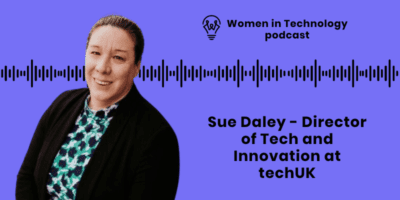Naomi Timperley is a growth and innovation consultant and co-founder of GSI. Naomi knows the tech space inside out and she is also one half of the team who set up Tech North Advocates. She also sits on multiple advisory boards and groups, as well as featuring in Computer Weekly’s list of the Top 50 Most Influential Women in UK IT for 2018, 2019, 2020,2021 and 2022.

“By highlighting diverse roles, we can help break down the age-old stereotype that the tech industry is only for ‘coders’ or ‘techies’, (usually expected to be male) and create a more inclusive industry that welcomes all individuals with different backgrounds and interests.”
Succeed and flourish
I’ve taken part in Womanthology many times over the years but by way of a recap for those who missed my previous pieces: I am a growth and innovation consultant working with start-ups and growth businesses across the UK. I am co-founder of GSI, working alongside Dr Vikas Shah MBE. I’m passionate about mentoring and I’ve mentored several hundred businesses over the past eight years. Nothing makes me prouder that seeing my mentees succeed and flourish. It’s the very best part of my role.
Wearing some of my other hats, I am co-founder of Tech North Advocates, a private sector-led advocacy that champions tech in the North. I’m a member of the Industry Advisory Board at the University of Salford Business School as well as being one of the University’s Honorary Industry Fellows. I sit on the board of the inclusion charity Digital Advantage and the social enterprise, PIE [Pursuing Individual Excellence]. I was previously chair of Future Everything.
Plan to succeed
My days vary from week to week — I work with some clients one-to-one with the founder, which might mean mentoring or helping them with a growth strategy, or helping their team create new products and services. I work with early start stage start-ups and growth business. I have designed and delivered several entrepreneurship programmes, predominately in the tech, digital and creative spaces.
In my business growth consulting work, I help businesses identify and pursue opportunities for growth, whether through expanding into new markets, developing new products or services, or optimising current operations. I also help businesses develop a clear and actionable plan for success, including setting goals, identifying resources and capabilities, and implementing strategies to achieve those goals. I enable clients to stay ahead of the curve by fostering a culture of innovation and helping them identify and pursue new ideas and opportunities.
Each and every day is totally different and I wouldn’t have it any other way.
Advancing diversity
The tech sector has been advancing in recent years to improve the inclusiveness of its culture. One of the main ways this is being accomplished is through increasing diversity in hiring practices. Many tech companies are actively seeking out candidates from underrepresented groups, including women, ethnic minorities, and individuals from disadvantaged socioeconomic backgrounds. This is being done through targeted recruitment efforts, including partnerships with organisations that focus on diversity and inclusion.
Another important aspect of creating a more inclusive tech culture is providing opportunities for training and education. Tech companies are investing in programmes that provide training and support to individuals who may not have had access to traditional tech education pathways. These programmes can range from coding bootcamps to apprenticeships, and can help individuals gain the skills they need to succeed in the tech industry.
Tech companies are also working to create a more inclusive workplace culture, through initiatives like unconscious bias training, mentorship programmess, and employee resource groups that focus on diversity and inclusion. Tech companies are also taking steps to address issues like pay equity, harassment, and discrimination, and are implementing policies and procedures to create a safer and more welcoming workplace for all employees.
It is important to create a culture that values work-life balance and prioritises employee wellness. Employers must make it clear to employees that all-night hackathons are not a necessary or expected part of their job, and encourage them to prioritise their health and well-being over working long hours.
The best tech employers are making a difference by:
- Providing alternatives. Instead of all-night hackathons, they are hosting shorter events during regular work hours or on weekends;
- Ensuring that events and activities are inclusive and welcoming to all employees;
- Encouraging open and respectful communication among team members;
- Leading by example. Leaders in the company should set the tone for a healthy work-life balance. They should model good habits and promote healthy work practices;
- Regularly seeking feedback from employees about their experiences with work events and activities. Use their feedback to make improvements and create a culture that values their health and well-being.

By creating a culture that prioritises employee wellness and work-life balance, companies can shift away from the brogrammer culture of all-night hackathons with beer and pizza. This will not only improve the health and well-being of employees, but also create a more productive and inclusive work environment.
The more inclusive alternative to hackathons
Design sprints and hackathons are two types of events that are commonly used in the tech industry to foster innovation and creativity. However, there are some key differences between the two.
A design sprint is a structured process for solving a specific problem or challenge. It typically involves a cross-functional team working together for a set period of time, usually a week or less. The team uses a series of exercises and techniques to rapidly prototype and test potential solutions, with the goal of creating a working prototype by the end of the sprint. Design sprints are often used to develop new products, features, or services.
On the other hand, a hackathon is an event where individuals or teams come together to collaborate on a project, often with a specific theme or goal in mind. The focus is on building something quickly, with the goal of creating a working prototype or demo by the end of the event. Hackathons can last anywhere from a few hours to a few days, and participants often work around the clock to develop their ideas.
While both design sprints and hackathons involve collaboration and rapid prototyping, there are some key differences between the two. Design sprints are more structured and focused on solving a specific problem or challenge, while hackathons are more open-ended and focused on building something quickly. Additionally, design sprints often involve cross-functional teams working together, while hackathons can be more individual or team-based.
Building Digital Advantage
I’m proud to be a trustee of Digital Advantage, which is an award-winning charity that delivers innovative work experiences to young people of all ages and abilities. Their industry-led programmes accelerate technical, creative and business skills to reveal the hidden talents of all our students.
Digital Advantage launched DISC last year. Based in Central Manchester, the Digital Independent Specialist College (DISC) opened its doors to support young people with a flair for digital and creative technology to prepare for adulthood and employment. Over the course of one year the group will develop their digital and creative work-based skills, improve their confidence and core employability traits and be supported into an apprenticeship, employment, self-employment or other positive destination in the digital economy.
It’s Back: New Dates for this fantastic opportunity for young people in Gtr Manchester, with disabilities, aged 18-24 to learn practical digital skills to kick start their careers. Choose 16-19 or 20-23 May To find out more email paul@digitaladvantage.org.uk#SEND #NEET please RT pic.twitter.com/VqYHbwvrDW
— Digital Advantage (@digivantage) April 25, 2022
Their unique Digital Supported Internship is for 16-24-year-olds with an Education Health and Care Plan (EHCP).
It is important to make sure the tech sector is inclusive of people who are neurodiverse because they bring unique perspectives and skills to the industry. People who are neurodiverse often have exceptional abilities in areas such as pattern recognition, attention to detail, and creative problem-solving.
By creating a more inclusive tech sector, companies can tap into the talents and abilities of neurodiverse individuals, which can lead to more innovative and effective solutions. To make the tech sector more inclusive of neurodiverse individuals, companies can take a number of steps. These include:
- Providing accommodations. This can include providing assistive technologies, flexible work arrangements, and other accommodations to help neurodiverse individuals thrive in the workplace;
- Fostering understanding and acceptance. Companies can provide training and education to help all employees better understand and appreciate the contributions of neurodiverse individuals;
- Recruiting and hiring neurodiverse individuals. Companies can actively recruit and hire neurodiverse individuals, and work to create an inclusive hiring process that accommodates different communication styles and interview formats;
- Creating a supportive workplace culture. Companies can create a workplace culture that values diversity and inclusivity, and provides support and resources for neurodiverse individuals and their colleagues.
Beyond brogrammer culture
It is important for career information about the tech sector to include all types of roles that don’t just revolve around coding because the tech sector is a diverse and rapidly growing industry that requires a wide range of skills and expertise beyond just programming.
By including information about different roles, we can help ensure that individuals with different backgrounds and skill sets can see themselves in the tech industry and find careers that align with their interests and strengths.
The tech sector includes roles in user experience design, project management, technical writing, marketing, data analysis, and cybersecurity, among others. These roles require different skill sets and backgrounds, and can be just as critical to the success of a tech company as software development roles.
By highlighting diverse roles, we can help break down the age-old stereotype that the tech industry is only for ‘coders’ or ‘techies’, (usually expected to be male) and create a more inclusive industry that welcomes all individuals with different backgrounds and interests.
This can also help address the talent shortage in the tech industry by attracting a wider pool of candidates with different skill sets and perspectives. By providing information about different roles, we can help individuals make informed career choices that align with their interests and skills, rather than simply following the well-trodden path of software development, the tech industry can attract a wider pool of candidates and create a more innovative and successful industry overall.





